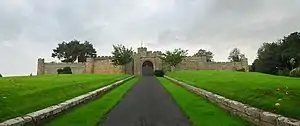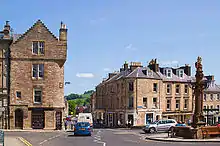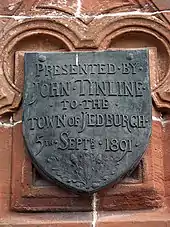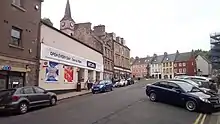Jedburgh
Jedburgh (/ˈdʒɛdbərə/; Scottish Gaelic: Deadard; Scots: Jeddart or Jethart)[3] is a town and former royal burgh in the Scottish Borders and the traditional county town of the historic county of Roxburghshire,[4] the name of which was randomly chosen for Operation Jedburgh in support of the D-Day invasion.
Jedburgh
| |
|---|---|
 "Strenue et Prospere", Earnestly and Successfully | |
 Jedburgh Location within the Scottish Borders | |
| Area | 1.74 km2 (0.67 sq mi) [1] |
| Population | 3,860 (mid-2020 est.)[2] |
| • Density | 2,218/km2 (5,740/sq mi) |
| OS grid reference | NT649205 |
| • Edinburgh | 41 mi (66 km) NW |
| Civil parish |
|
| Community council |
|
| Council area | |
| Lieutenancy area | |
| Country | Scotland |
| Sovereign state | United Kingdom |
| Post town | JEDBURGH |
| Postcode district | TD8 |
| Dialling code | 01835 |
| Police | Scotland |
| Fire | Scottish |
| Ambulance | Scottish |
| UK Parliament | |
| Scottish Parliament | |
| Website | http://www.jedburgh.org.uk/ |
Location
Jedburgh lies on the Jed Water, a tributary of the River Teviot. It is 10 miles (16 km) from the border with England, and is dominated by the substantial ruins of Jedburgh Abbey. Other notable buildings in the town include Queen Mary's House, Jedburgh Castle Jail, now a museum, and the Jedburgh Library.
Other places nearby are Ancrum, Bairnkine, Bonjedward, Camptown, Crailing, Edgerston, Ferniehirst Castle, Nisbet and Oxnam.

History
Jedburgh began as Jedworð, the "worth" or enclosed settlement on the Jed. Later the more familiar word "burgh" was substituted for this, though the original name survives as Jeddart/Jethart.[5]
Bishop Ecgred of Lindisfarne founded a church at Jedburgh in the 9th century, and King David I of Scotland made it a priory between 1118 and 1138, housing Augustinian monks from Beauvais in France. The abbey was founded in 1147, but border wars with England in the 16th century left it a ruin.[6]
The deeply religious Scottish king Malcolm IV died at Jedburgh in 1165, aged 24. His death is thought to have been caused by Paget's disease of bone.[7]
David I built a castle at Jedburgh, and in 1174 it was one of five fortresses ceded to England. It was an occasional royal residence for the Scots. It was demolished in 1409.[8]
In 1258, Jedburgh was a focus of royal attention, with negotiations between Scotland's Alexander III and England's Henry III over the succession to the Scottish throne, leaving the Comyn faction dominant. Alexander III was married to Yolande in the abbey in 1285.[9]
In 1307, James Douglas, fighting for King Robert Bruce, took Jedburgh from the English with little effort.[10]
Its proximity to England made it subject to raids and skirmishes by both Scottish and English forces but its strategic position also brought the town valuable trade. At various times and at various locations the town supported a horse market, a cattle market, a corn market and a butcher market. Farm workers and servants also attended hiring fairs seeking employment.[11]
Mary, Queen of Scots, stayed at a certain house in the town in 1566 and that house is now a museum – Mary Queen of Scots House.[12]
The title "Lord of Jedburgh Forest" was granted to George Douglas, 1st Earl of Angus on his marriage to the Princess Mary, daughter of Robert III in 1397.[13] The titles of Archibald Douglas, 1st Duke of Douglas included "Viscount Jedburgh Forest", but he died without an heir in 1761.[14]
On 6 November 1745, the Jacobite army led by Prince Charles Edward Stuart passed through the town on its way to England.[15] The Castle Prison opened in 1823.[8]
In 1787, the geologist James Hutton noted what is now known as the Hutton Unconformity[16] at Inchbonny, near Jedburgh.[17][18] Layers of sedimentary rock which are tilted almost vertically are covered by newer horizontal layers of red sandstone.[19] This was one of the findings that led him to develop his concept of an immensely long geologic time scale with "no vestige of a beginning, no prospect of an end."[16]
The Scots name for the town is part of the expression "Jeddart justice" or "Jethart Justice", in which a man was hanged first, and tried afterwards.[20]

Jedburgh became the county town of Roxburghshire after the original county town of Roxburgh was abandoned following the destruction of Roxburgh Castle in 1460 during the Anglo-Scottish Wars. In 1812 County Buildings was built at the junction of Market Place and Castlegate in Jedburgh, serving as both a sheriff court and meeting place for the Commissioners of Supply.[21] Roxburghshire County Council was created in 1890 and continued to meet at the County Buildings until 1930 when it moved its meetings to County Offices at Newtown St Boswells.[22]
Notable people

Several notable people were born in the town, including Rev Dr Thomas Somerville's niece, Mary Somerville, in 1780[23] (the eminent scientist and writer, after whom Somerville College, Oxford is named, and who appeared on the Royal Bank of Scotland £10 note from 2017).
James Thomson (1700–1748) who wrote "Rule Britannia", was born in Ednam, a village only twelve miles away, but he was educated in Jedburgh.[24] David Brewster, physicist, mathematician, scientist, writer and inventor of the kaleidoscope, was born in Jedburgh in 1781.[25] The popular preacher Rev. Robert Aitken (1800–1873) was born in Crailing near Jedburgh.[26] General Sir Bindon Blood was born nearby in 1842.[27] Alexander Jeffrey (F.S.A. Scot.) was a solicitor in the town and was also the county historian: he lived in Jedburgh until his death in 1874.[28] The author and broadcaster Lavinia Derwent was born in a farmhouse a few miles outside Jedburgh in 1909.[29] The Tinline brothers emigrated from Jedburgh in the late 1830s. George Tinline made a career in banking in Australia.[30] John Tinline went to New Zealand and made his wealth in farming. John returned to Jedburgh later in life and gifted Allerley Well Park to his hometown.[31]
The town's well known rugby players are the scrum-halves, Roy Laidlaw,[32] his nephew, Scotland rugby team captain Greig Laidlaw[33] and Gary Armstrong.[34] Douglas Young fought at Heavyweight at the 1984 Summer Olympics.[35]
Emmy Award-winning journalist Nick Watt is from Jedburgh and hosted a short film about the town for the Travel Channel.[36]
The town today

The abbey is maintained by Historic Environment Scotland and open to the public (there is an entry fee). Finds from excavations are displayed on site in the visitor centre attached to the Abbey ruins. The shell of the abbey, though much damaged over the years, is still largely complete.[37]
Traditional festivals and performers include the annual Callant's Festival, and Jedburgh Royal British Legion (Scotland) Pipe Band and Jedforest Instrumental Band.[38] Local delicacies include Jethart Snails (boiled sweets in the shape of a snail, said to originate from a recipe given to a local baker by a French prisoner, during the Napoleonic Wars)[39][40] and Jethart pears. The fertile soil of Jedburgh makes it good for growing pear trees, and the pear trade was a thriving industry in Jedburgh for centuries.[41]
An annual event is the Jethart Hand Ba game.
The Canongate Brig dates from the 16th century. The nearby Capon Oak Tree is recognised to be of national interest[42] and the 19th century Jedburgh Castle Jail[43] and Newgate, with its spire, are among the town's notable buildings.[44]
Schooling currently takes place at Jedburgh Intergenerational Community Campus, which opened in early 2020.[45]
Transport
Although Jedburgh no longer has any rail access it is well located on the road network. The A68 provides direct access to Edinburgh (48 miles (77 km)) and Newcastle-upon-Tyne (58 miles (93 km)). Carlisle is 57 miles (92 km) away and Hawick, Kelso, Selkirk and Galashiels are all within 20 miles (30 km).
Jedburgh is known to motorists from the Edinburgh and Newcastle-upon-Tyne areas as Jedburgh is signposted as a primary destination on the A68.
Bus services to Jedburgh are provided by Borders Buses.[46] Until July 2013 they were mostly run by local operator Munro's of Jedburgh.[47]
Sport
The town is home to a Rugby Club, Jed-Forest which was founded in 1885.[48] Under-18 "Semi Junior" rugby is played by Jed Thistle at Lothian Park.[49]
Football is represented by Jed Legion FC which currently plays in 'A' League of the Border Amateur League.[50] Ancrum AFC play in the village of Ancrum just to the north at Bridgend Park and are in the Border Amateur 'B' League.[51]
Jedburgh has a golf club dating from 1892, the course has 18 holes.[52]
See also
References
- "Mid-2012 Population Estimates for Settlements and Localities in Scotland". National Records of Scotland. 31 July 2014. Retrieved 24 December 2021.
- "Mid-2020 Population Estimates for Settlements and Localities in Scotland". National Records of Scotland. 31 March 2022. Retrieved 31 March 2022.
- "Scots Language Centre: Scottish Place Names in Scots". Scotslanguage.com. Retrieved 12 January 2013.
- Groome's Ordnance Gazetteer of Scotland, 2nd edition, published 1896. Article on Jedburgh.
- Williamson, May (1942). "The Non-Celtic Place-Names of the Scottish Border Counties" (PDF). Edinburgh University. pp. 16–17.
- This article incorporates text from a publication now in the public domain: Chisholm, Hugh, ed. (1911). "Jedburgh". Encyclopædia Britannica. Vol. 15 (11th ed.). Cambridge University Press. pp. 299–300, see page 299.
...David, prince of Cumbria, here founded a priory for Augustinian monks..... and in 1147, [he] erected it into an abbey...Repeatedly damaged in Border warfare, it was ruined in 1544–45...
- Scott, W. W. (23 September 2004). "Malcolm IV (1141–1165), king of Scots". Oxford Dictionary of National Biography. Oxford Dictionary of National Biography (online ed.). Oxford University Press. doi:10.1093/ref:odnb/17860. (Subscription or UK public library membership required.)
- Historic Environment Scotland. "Castlegate, Jedburgh Castle Old Jail with exercise yard walls, fortifications, portcullis gates, entrance gates and outer embankment wall (Category A Listed Building) (LB35482)". Retrieved 21 February 2019.
- Connolly, Sharon Bennett (15 September 2017). Heroines of the Medieval World. Amberley Publishing. pp. 116–. ISBN 978-1-4456-6265-7.
- Crome, Sarah, Scotland's First War of Independence, 1999, at p. 100
- Olsen, Judy (2003). Old Jedburgh. Catrine, Ayrshire: Stenlake Publishing. p. 3. ISBN 9781840332360. Archived from the original on 15 December 2019. Retrieved 26 July 2013.
- "Mary Queen of Scots House". Jedburgh.org.uk. 2012–2017. Retrieved 6 September 2017.
- The Register of the Privy Council of Scotland. Vol. 11. H.M. General Register House. 1894. p. LXXVIII.
- Complete Peerage of England, Scotland, Ireland, Great Britain and the United Kingdom, Extant, Extinct, Or Dormant. Vol. 3. G. Bell and Sons. 1890. p. 159.
- Lang, Andrew (1903). Prince Charles Edward Stuart: The Young Chevalier. Longman, Green & Company. p. 201.
- "James Hutton: The Founder of Modern Geology". Earth: Inside and Out. American Museum of Natural History. 2000. Archived from the original on 3 March 2016.
- Graphic Design Section (1999). "Border Brains Walks Berwickshire". Scottish Borders Council. Retrieved 29 June 2012.
- Montgomery, Keith (2003). "Siccar Point and Teaching the History of Geology" (PDF). University of Wisconsin. Retrieved 26 March 2008.
- "Visitor Attractions. Hutton's Unconformity". Jedburgh online. Archived from the original on 2 February 2012. Retrieved 29 June 2012.
Whilst visiting Allar's Mill on the Jed Water, Hutton was delighted to see horizontal bands of red sandstone lying 'unconformably' on top of near vertical and folded bands of rock.
- Trimble, Kim. "The Reivers". www.turnbullclan.com. Archived from the original on 28 March 2018. Retrieved 28 March 2018.
- Historic Environment Scotland. "Jedburgh Sheriff Court and Justice of the Peace Court (Former County Buildings) including wall and railings, Castlegate, Jedburgh (Category B Listed Building) (LB35503)". Retrieved 12 December 2022.
- "County Council meeting: Jedburgh meeting place to be abandoned". Hawick News. 19 December 1930. p. 6. Retrieved 13 December 2022.
- Somerville, Mary Fairfax Greig. Dictionary of Scientific Biography. Vol. 11 & 12. New York: Charles Scribner's Sons. 1981. pp. 521–522.
- "James Thomson". Westminster Abbey. Dean and Chapter of Westminster. Retrieved 25 July 2022.
- "Inventor of the Kaleidoscope". Brewster Kaleidescope Society. Retrieved 25 July 2022.
- Boase, Frederic (2018). Modern English Biography: A-H. Vol. 1. Litres. p. 1868. ISBN 9785041269647.
- Riddick, John F. (1998). Who was who in British India. Greenwood Press. p. 37. ISBN 978-0313292323.
- Proceedings of the Society of Antiquaries of Scotland. Vol. 8. Society. 1871. p. 393.
- "Moira Burgess: "Dodd, Elizabeth (pseud. Lavinia Derwent)"". Oxford Dictionary of National Biography (online ed.). Oxford University Press. 2005. doi:10.1093/ref:odnb/74090. Retrieved 22 October 2022. (Subscription or UK public library membership required.)
- Hirst, Christine (1976). "Tinline, George (1815–1895)". Australian Dictionary of Biography. Vol. 6. National Centre of Biography, Australian National University. ISSN 1833-7538. Retrieved 2 April 2020.
- Scholefield, Guy, ed. (1940). A Dictionary of New Zealand Biography : M–Addenda (PDF). Vol. II. Wellington: Department of Internal Affairs. p. 386. Retrieved 2 April 2020.
- "Roy James Laidlaw". ESPN scrum. Retrieved 5 October 2021.
- "Jedburgh rugby star Greig Laidlaw and Gordon Paralympian Sammi Kinghorn to lead 2022 Doddie Aid fundraising in Borders". Southern Reporter. 4 January 2022. Retrieved 22 October 2022.
- "The 50 Greatest Scottish Rugby Players Part VI 3 - 1". The Herald. 12 September 2015. Retrieved 20 January 2018.
- "Boxing at the 1984 Los Angeles Summer Games: Men's Heavyweight". Sports Reference. Archived from the original on 18 April 2020. Retrieved 15 September 2021.
- "Nick Watt's Hometown". Travel Channel. 2015. Retrieved 28 April 2020.
- Historic Environment Scotland. "Jedburgh Abbey, 50m ESE of Abbey House (SM13126)". Retrieved 21 February 2019.
- "Jedforest Instrumental Band celebrate to the tune to £63,000 cash boost". Southern Reporter. 11 February 2020. Retrieved 22 October 2022.
- Herdman, John (22 November 1992). The County of Roxburgh. Scottish Academic Press. ISBN 9780707307206 – via Google Books.
- Davidson, Alan (22 January 2014). The Oxford Companion to Food. Oxford University Press. ISBN 9780199677337 – via Google Books.
- "Mary Queen of Scots: the origins of Jedburgh's once celebrated pear-production". The Forestry Journal. 3 February 2021. Retrieved 22 October 2022.
- "Tree - Ancient Tree Inventory". ati.woodlandtrust.org.uk. Retrieved 9 September 2021.
- Wood, John R. I.; Muñoz-Rodríguez, Pablo; Williams, Bethany R. M.; Scotland, Robert W. (16 March 2020). "Figure 20 from: Wood JR.I, Muñoz-Rodríguez P, Williams BR.M, Scotland RW (2020) A foundation monograph of Ipomoea (Convolvulaceae) in the New World. PhytoKeys 143: 1-823". doi:10.3897/phytokeys.143.32821.figure20. S2CID 241349084.
{{cite journal}}: Cite journal requires|journal=(help) - Historic Environment Scotland. "Newgate, Abbey Place, Jedburgh (35247)". Retrieved 22 October 2022.
- "Jedburgh Grammar Campus joins Doors Open Days Festival line up". Scottish Borders Council. 25 August 2022. Retrieved 22 October 2022.
- "Borders Buses Timetables". Retrieved 1 July 2017.
- "Munro's of Jedburgh – Home Page". Munrosofjedburgh.co.uk. 8 August 2011. Retrieved 12 January 2013.
- "Application for financial assistance" (PDF). Scottish borders council. 23 January 2017.
- "Thistle display merciless form to gain vengeance over rivals". Southern Reporter. 6 December 2018. Retrieved 22 October 2022.
- "Border Amateur Football League ::Border Amateur Football League". Bafl.leaguerepublic.com. Retrieved 12 January 2013.
- "Tweeddale in comfortable friendly win over Ancrum". Southern Reporter. 28 July 2021. Retrieved 22 October 2022.
- "My Homepage". Jedburgh Golf Club.
External links
- This article incorporates text from a publication now in the public domain: Chisholm, Hugh, ed. (1911). "Jedburgh". Encyclopædia Britannica. Vol. 15 (11th ed.). Cambridge University Press. pp. 307–308.
- Jedburgh Town Website
.jpg.webp)

